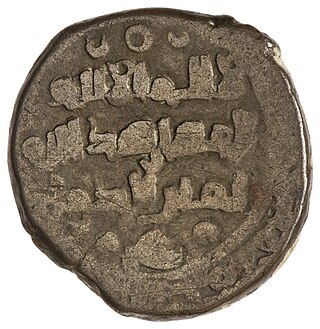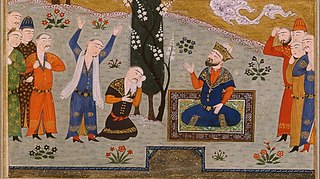Related Research Articles

Malik-Shah I, was the third sultan of the Seljuk Empire from 1072 to 1092, under whom the sultanate reached its zenith of power and influence.

Ahmad Sanjar was the Seljuq ruler of Khorasan from 1097 until 1118, when he became the Sultan of the Seljuq Empire, which he ruled until his death in 1157.

Mughith al-Dunya wa'l-Din Mahmud bin Muhammad known as Mahmud II was the Seljuk sultan of Baghdad from 1118–1131 following the death of his father Muhammad I Tapar. At the time Mahmud was fourteen, and ruled over Iraq and Persia.

Rukn al-Din Abu'l-Muzaffar Berkyaruq ibn Malikshah, better known as Berkyaruq (برکیارق), was the fifth sultan of the Seljuk Empire from 1094 to 1105.
Khwarazmshah was an ancient title used regularly by the rulers of the Central Asian region of Khwarazm starting from the Late Antiquity until the advent of the Mongols in the early 13th-century, after which it was used infrequently. There were a total of four families who ruled as Khwarazmshahs—the Afrighids (305–995), Ma'munids (995–1017), the line of Altuntash (1017–1041), and the most prominent ones, the Anushteginids (1097–1231). Like other contemporary Central Asian titles, such as Afshin and Ikhshid, the title of Khwarazmshah is of Iranian origin.

Ala al-Din wa-l-Dawla Abu'l-Muzaffar Atsiz ibn Muhammad ibn Anushtegin, better known as Atsiz (اتسز) was the second Khwarazmshah from 1127/8 to 1156. He was the son and successor of Muhammad I.
Jalal-ud-Din Sultan-Shah, known as Sultan-Shah was a claimant to the title of Khwarazmshah from 1172 until his death. He was the son of Il-Arslan.

Il-Arslan was the Shah of Khwarezm from 1156 until 1172. He was the son of Atsïz.
Mu'ayyid al-Din Ai-Aba was the amir of Nishapur from c. 1154 until his death. Although nominally subservient to the Seljuks of Khurasan, he acted as an independent ruler. Due to his control of much of Khurasan, the historian Ibn Funduq called him "Emperor of Khurasan, King of the East."
Ikhtiyar al-Din Ai-Taq was an influential amir in western Khurasan following the decline of the Seljuks, and the ruler of Gurgan and Dihistan from 1161 until 1165.
Sanjar-Shah was the amir of central Khurasan from 1185 or 1186 until 1187. His short reign was ended by a Khwarezmid invasion and resulted in the takeover of Nishapur by Khwarezm.
Malik Dinar was the Ghuzz ruler of Sarakhs from c. 1153 until 1179. He was also the ruler of the province of Kerman from 1186 until his death.
The Khwarazmian or Khwarezmian Empire was a culturally Persianate, Sunni Muslim empire of Turkic mamluk origin. Khwarazmians ruled large parts of present-day Central Asia, Afghanistan, and Iran in the approximate period of 1077 to 1231, first as vassals of the Seljuk Empire and the Qara Khitai, and from circa 1190 as independent rulers, up until the Mongol conquest in 1219–1221.

Bahram-Shah was Sultan of the Ghaznavid Empire from 25 February 1117 to 1152. Son of Mas'ud III and Gawhar Khatun, sister of Sanjar, sultan of the Great Seljuq Empire. During his entire reign, his empire was a tributary of the Great Seljuq Empire.
Ali I, was the ruler of the Bavand dynasty from 1118 to 1142. He was the uncle and successor of Rustam III.
Bahram ibn Shahriyar, was an Iranian prince from the Bavand dynasty.

Athir al-Din Akhsikati was an Iranian writer, whose ghazals in Persian played an important role in the development of the genre.
Gawhar Khatun, known in other sources as Mahd-i Iraq, was a Seljuq princess who during an unknown date married the Ghaznavid Sultan Mas'ud III of Ghazni, thus becoming his second wife.
Mu'izz al-Dunya wa'l-Din Abu'l-Harith Suleiman-Shah bin Muhammad, was sultan of the Seljuq Empire from 1159 to 1160.

Shah Ghazi Rustam, was king of the Bavand dynasty of Mazandaran, ruling from 1142 to 1165. He expanded the borders of the kingdom at the expense of his neighbors, particularly the Ismailis and the Seljuks. He established a Bavandid presence in Gilan as a result of his frequent vengeful raids against the Ismailis, who had assassinated his son and heir, Girdbazu. He also brought Qumis and Ray under Bavandid control during his wars against the Seljuks and the Karakhanids.
References
- Bosworth, C.E. "The Political and Dynastic History of the Iranian World (A.D. 1000-1217)." The Cambridge History of Iran, Volume 5: The Saljuq and Mongol Periods. Edited by J.A. Boyle. Great Britain: Cambridge University Press, 1968. ISBN 052106936X